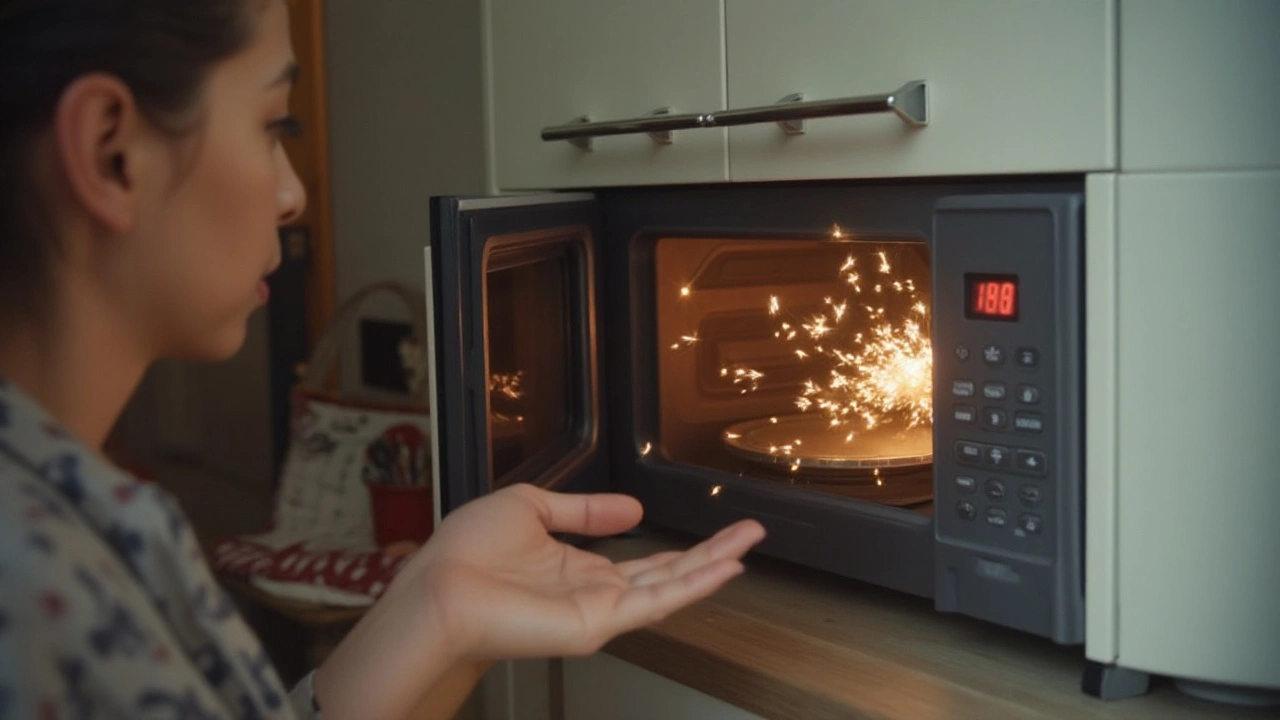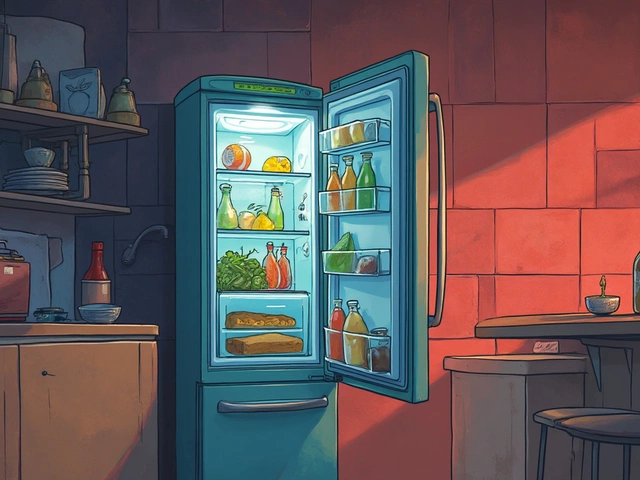The microwave, a staple of modern convenience, often toils away unnoticed on our kitchen countertops until something goes awry. While most household appliances can falter over time, recognizing the signs that indicate a microwave is going bad can save you a headache and maintain your kitchen's safety.
From odd noises to stubborn buttons that refuse to cooperate, these warning signs aren't just quirks—they're the machine's way of asking for a bit of attention. It's crucial to listen to these cues; acknowledging them can mean the difference between a minor repair and needing a brand new machine.
By understanding what these signs mean, you can make informed decisions on whether to troubleshoot the issue yourself, call a professional, or perhaps consider an upgrade. In many instances, early detection and action can keep a small inconvenience from turning into a significant problem.
- Unusual Noises and Smells
- Inconsistent Heating
- Physical Damage
- Malfunctioning Controls
- Safety Concerns and Next Steps
Unusual Noises and Smells
When your trusty microwave begins to serenade you with unfamiliar sounds, it's essential to pay attention. Unusual noises often signal internal troubles that could lead to serious issues if ignored. The hum of a microwave should typically be a consistent, low-level sound—if it's not, then it's time to investigate. Uncharacteristic thumping, scraping, or buzzing may indicate a worn-out or misaligned turntable, a defective magnetron causing electrical issues, or a failing fan motor struggling to keep the device cool. Each of these scenarios can affect the overall performance of the microwave, potentially leaving you with undercooked meals or an appliance that doesn't function at all.
Strange smells also warrant immediate attention. Smells of burning plastic or electrical fire are particularly concerning. These could mean burning wires or an overheated component within the unit. Such occurrences not only compromise the microwave's functionality but can also pose serious safety risks, including fire hazards. An often overlooked factor is the buildup of food particles inside the microwave, which, when perpetually heated, can create persistent odors that mask more sinister smells. Keeping the appliance clean can mitigate some risks, but persistent, unusual odors should prompt further inspection. Microwave problems related to unusual smells might require an expert opinion to assess and rectify if beyond basic cleaning.
Being able to discern between benign and dangerous noises and smells can prevent bigger complications. If you find the noises or smells changing, it might be wise to consult with a professional or, at the very least, unplug the appliance until you can determine what's wrong. According to Consumer Reports, "Routine maintenance and prompt attention to any changes can significantly extend the lifespan of your kitchen appliances." Never underestimate a microwave repair when unusual noises and smells arise. Letting these signs go unchecked can quickly transform a well-functioning kitchen necessity into a dangerous liability.
To assess these issues, follow some basic troubleshooting steps: Unplug the microwave and let it cool, then carefully inspect the interior and exterior. Check that the microwave's turntable is properly seated, its rollers are unobstructed, and there is no food residue clinging to the surfaces or blocking the vents. If noisy operations or smoky smells continue even after cleaning and resetting, a professional inspection is the best course of action.
Understanding the importance of these signs and addressing them in time can save you money and ensure your appliance works safely and efficiently. By acknowledging these early signals, you're not just reacting to a fault; you're actively maintaining the heartbeat of your culinary operations.
Inconsistent Heating
When your microwave starts to heat food unevenly, it's not just a nuisance; it's a sign of potential trouble on the horizon. Have you ever put a dish in, expecting hot leftovers, only to find icy patches next to scalding spots? This might seem minor at first, but inconsistent heating can hint at a deeper issue within your valuable kitchen appliance. Often, the culprit may be the microwave’s magnetron, a component responsible for generating the heat. If it starts to malfunction, the heating can become erratic—or stop altogether. While you might be tempted to shrug it off, overlooking this sign can lead to full-on failure.
Another usual suspect when dealing with uneven cooking is the turntable motor. If your microwave's turntable isn't spinning like it should, it won't distribute the microwaves evenly across the food, leading to those pockets of cold surrounded by hot. You can test this yourself by running the microwave with a glass of water and seeing if the turntable rotates smoothly throughout its cycle. However, if you hear odd noises or the spinning seems labored, it might be due for a check-up.
Sometimes, simple wear and tear on the microwave's cooling fan or air vents can also cause heating issues. Blocked vents can cause the internal temperature to spike, which might not only unevenly heat your meals but can also trigger the microwave to auto-shut for safety, disrupting the process. Cleaning these vents regularly ensures good airflow and proper functioning. Pay attention to maintenance tips, and avoid overpacking your microwave, as overcrowding can prevent those microwave problems from creeping in.
Expert opinions in the field, like those from appliance technicians, often caution against ignoring these signs. As cited in a recent industry article, "Addressing small inconsistencies early can help avoid larger, costlier repairs later on." It's wise advice that can save a lot of hassle and expense. It’s always a great idea to have your microwave checked by a professional if you notice persistent performance issues, ensuring all components are working as they should.
For the DIY-ers among us, there are small maintenance tasks you can perform regularly. Cleaning the inside of your microwave might sound basic, but grease accumulation can interfere with how heat distributes. A simple mixture of water and lemon heated in the microwave can work wonders to loosen splattered food particles. Always replace or properly fix a cracked waveguide cover, the small panel inside that plays a crucial role protecting internal components from food debris.
Sometimes, these inconsistent heating issues could be a sign that it might be time to invest in a new, upgraded microwave model. With advances in technology, there are many energy-efficient options available that not only offer consistent cooking but also add smart features for your convenience. Consider the financial and environmental benefits of modern, energy-saving appliances.

Physical Damage
When it comes to household appliances, especially a microwave, any visible wear and tear shouldn't be ignored. Physical damage can be both an indication and a cause of deeper issues. From dents, scratches, and cracks on the exterior shell to damage within the interior cavity, these are more than mere cosmetic concerns. A dented body might suggest past impacts, and while the machine may seem to work fine, such damage can affect the integrity of components inside. This could lead to issues with the door's ability to seal properly, which is crucial for the safe operation of a microwave.
One of the more common issues that arise from physical damage is related to the door and its hinges. If the door doesn't close properly, it can prevent the machine from functioning as designed. This is because microwaves have safety interlocks that ensure the door is securely shut before it starts operating. If these interlocks are damaged or misaligned, the microwave might not start at all, or worse, it might leak radiation, posing potential safety risks. It’s important to inspect these areas closely and regularly.
Another area of concern lies in the microwave's interior. If you notice burn marks, warping, or cracks inside the cooking cavity, it's crucial to address the problem promptly. Such damage can hinder the effectiveness of the microwave's operation and affect the appliance's ability to cook or heat food evenly. Sometimes, these signs are early indicators of more serious underlying issues, such as short-circuited wiring or a failing magnetron, the component responsible for generating heat.
In addition to inspecting the physical aspects of the microwave, keep an eye out for irregularities when operating it. If you hear unusual noises or feel excessive warmth coming from the microwave's exterior surfaces, these could indicate internal physical damage or wear to electrical components. Through careful observation and regular maintenance checks, you can mitigate risks associated with physical damage before they escalate into more significant problems.
To maintain the longevity and efficiency of your microwave, regular cleaning is essential. Using it as a guide to detect underlying problems, cleaning helps to identify spills or residues that may otherwise be hidden. Accumulated moisture or food debris can disguise or contribute to damage in surprising ways, so a clean microwave not only makes meals more appetizing but also protects the machine itself.
On an interesting note, when approaching microwave maintenance or assessment, some experts suggest using a simple test with a paper towel to detect seal integrity. Close a paper towel in the microwave's door, leaving a small part hanging out. If you can easily pull it out without opening the door, you might have a seal problem. Reflecting the wisdom of professionals in the field, taking these small, proactive tasks to maintain and check physical condition can go a long way toward extending your microwave's life.
Malfunctioning Controls
When your microwave's controls begin to misbehave, it's easy to feel a sense of frustration stirring. You press a button, and instead of the expected response—a delightful hum signaling your food is warming—you are met with silence, a beep, or perhaps the microwave's electronic glare questioning your input. These malfunctioning controls can arise from various causes, and understanding their origins can help you tackle them effectively. Often, an appliance might misinterpret commands due to outdated software, a power surge, or simply worn-out touchpads. Dust accumulation around the control area can also play a silent yet significant role in these hiccups.
Modern microwaves often come equipped with keypads that respond to touch, relying on an intricate network of circuits beneath their sleek surfaces. As these microwaves age, their touch responsiveness can falter, due to either physical wear or internal wire disconnections, leaving users jabbing at icons without results. It’s here that knowing a bit about the average lifespan of microwave components becomes handy—buttons might lose their responsiveness over time, usually spanned across 5-10 years. If your microwave is nearing this age, it might be communicating its limits.
Another key aspect of malfunctioning controls is the settings' memory. Microwaves with digital interfaces often store recent settings to allow for quicker use. If these settings reset unexpectedly or present incorrect defaults, it might be due to internal memory failure. A common fix involves checking your microwave’s manual for reset functions, which can sometimes fix glitches almost magically. Yet, if home remedies fail, consulting a professional becomes advisable.
Microwave repair incurs cost considerations, but investing in fixing controls given their frequency of use is often worthwhile. Financially, attempting minor adjustments yourself can keep costs down. If your buttons are outright jammed or sticky from repeated spills and uncleaned residues, a gentle cleaning using a vinegar solution can often clear the problem. In the words of maintenance expert Michael Grimshaw, “Regular maintenance cuts down repair needs by 40%,” underscoring the importance of upkeep.
“Regular maintenance cuts down repair needs by 40%,” - Michael Grimshaw
Of course, if the cost of repair surpasses the price of a new appliance, it might be time for an upgrade. With the rapid improvement in microwave technology, new models often offer energy-saving modes, better design, and more reliable touch panels. Consider comparing prices from different suppliers. Knowing when to let go of the old and embrace the new is part of smart kitchen management, ensuring you not only have a functioning appliance but also enjoy improved energy efficiency, which translates to savings on your electricity bill, ultimately.

Safety Concerns and Next Steps
The microwave is a marvel of engineering, taking the hard work out of meal preparation with a few button presses. However, when it's not working as it should, safety becomes a concern that you shouldn't take lightly. A common but serious issue is arcing, when sparks fly inside the microwave because of metal or faulty components. Keeping your microwave clean and avoiding any metal objects inside can prevent this hazard. If you spot sparks and can't figure out why, it's crucial to cut power immediately and call in a professional to assess the situation.
Another potential problem is radiation leakage. While most modern microwaves have safeguards against this, damage to the door seals or latches can create leaks. Surprisingly, a small leak here and there might not cause immediate harm, but prolonged exposure is a different story. It's always wise to regularly inspect your microwave's physical integrity, noting any changes or damage to these key areas. If the microwave door isn’t sealing properly, it’s time to stop using it until repairs are made.
When to Say Goodbye
There comes a time when repair costs can equal or surpass the price of a new microwave. Knowing when to retire your trusty appliance is just as important as knowing how to fix it. Older models, especially those over a decade old, may not have the energy efficiency of newer ones, leading to higher electricity bills. Investing in a new microwave not only saves you from repair costs but might also result in a noticeable decrease in energy consumption. The Environmental Protection Agency suggests upgrading production models with ENERGY STAR options, which can save you up to 20% in energy costs.
It's worth remembering that microwaves, unlike some home appliances, have a relatively short lifespan. While some can last up to a decade, most start showing their age before then. According to experts, a microwave’s average lifespan ranges between seven to ten years, depending on usage and upkeep. When repairs become too frequent or costly, it’s often smart to consider their advice and start researching replacements. You can find some excellent resources online, including reviews and buying guides to help choose the right model for your needs.
“Repair or replace wants to be a proactive decision, not a reactive one,” advises Jane Luxton, a consumer appliance expert. “If something serious like sparking happens, that's a sign you shouldn't ignore.”
Microwave problems aren't just annoyances—they can pose serious risks if not addressed promptly. Always prioritize safety and, when unsure, consult a professional before taking action. Staying informed and acting decisively ensures that you and your family can continue cooking with confidence, knowing your kitchen is as safe as it is convenient.







